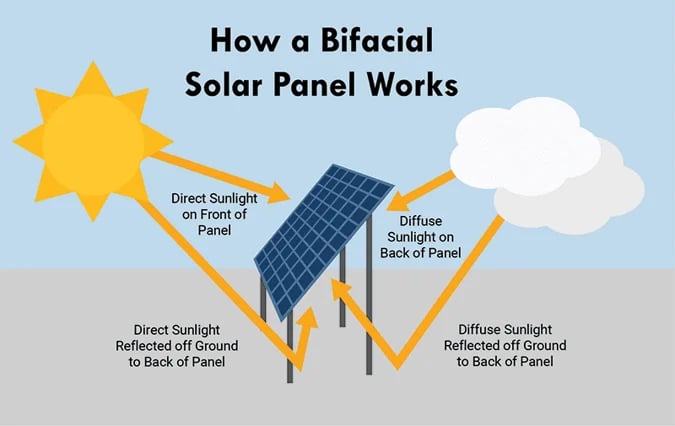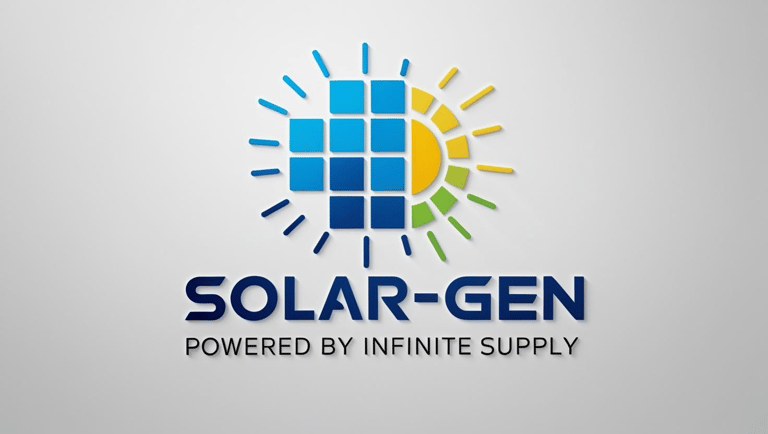Bifacial Solar Panels: Pros, Cons, and Applications
Is it worth it to go with Bifacial panels or regular ones will do? I've created a comprehensive guide about bifacial solar panels. The blog covers what these innovative panels are, their key advantages and disadvantages, and the situations where they make the most sense. Some highlights from the guide: Bifacial panels can generate 5-30% more energy than traditional panels by capturing reflected light on their rear side They're particularly effective in ground-mounted systems with reflective surroundings, elevated installations, and commercial flat rooftops While they typically cost 5-15% more upfront, they often offer better durability with glass-on-glass construction and longer warranties The technology isn't ideal for all situations, particularly traditional residential roof installations with dark roofing materials
3/6/20254 min read


Bifacial Solar Panels: Harnessing Energy from Both Sides
In the ever-evolving world of solar technology, bifacial solar panels represent one of the most promising innovations. Unlike traditional monofacial panels that capture sunlight only from the front, bifacial panels collect solar energy from both sides, potentially revolutionizing how we think about solar installations. This guide explores what bifacial solar panels are, their advantages and disadvantages, and whether they might be right for your solar project.
What Are Bifacial Solar Panels?
Bifacial solar panels are designed with photovoltaic cells on both sides of the module, allowing them to capture direct sunlight on the front face while simultaneously absorbing reflected light on the rear side. Most bifacial panels use either monocrystalline or polycrystalline silicon cells, and they typically feature transparent backing materials (glass or clear polymers) instead of the opaque backsheets found in conventional panels.
The technology itself isn't new—bifacial solar cells have existed since the 1960s—but recent manufacturing advances, coupled with decreasing costs and improved efficiency, have brought them into the mainstream market.
Pros of Bifacial Solar Panels
1. Increased Energy Production
The primary advantage of bifacial panels is their ability to generate more electricity in the same footprint. The rear side can capture an additional 5-30% energy depending on installation conditions, with some manufacturers claiming even higher gains in optimal environments. This "bifacial gain" directly improves the system's overall yield and can significantly enhance your return on investment over time.
2. Longevity and Durability
Many bifacial panels feature glass-on-glass construction, making them more durable than traditional panels with backsheets that can degrade over time. This construction method often translates to:
Extended warranties (some manufacturers offer 30+ year warranties)
Better resistance to environmental factors like humidity and salt mist
Reduced potential for microcracks and cell degradation
Lower annual degradation rates
3. Space Efficiency
For space-constrained installations, bifacial panels offer more energy production per square foot, potentially making smaller installations more economically viable. This advantage becomes particularly relevant in commercial or industrial settings where space utilization directly impacts project economics.
4. Aesthetically Pleasing Design
The transparent or translucent nature of bifacial panels gives them a sleeker, more modern appearance compared to traditional panels. This aesthetic quality makes them attractive options for visible installations like solar carports, pergolas, or architectural features where appearance matters.
5. Versatility in Application
Bifacial panels excel in various specialized applications:
Vertical installations (east-west facing)
Solar noise barriers along highways
Agricultural settings (agrivoltaics)
Snow-prone regions (reflected light from snow enhances rear-side production)
Flat commercial rooftops with reflective membranes
Cons of Bifacial Solar Panels
1. Higher Upfront Cost
Bifacial panels typically command a 5-15% price premium over comparable monofacial models. While this gap has narrowed in recent years, the additional cost must be justified by sufficient bifacial gain to make economic sense.
2. Installation Complexity
To maximize bifacial benefits, installations require:
Elevated mounting systems that allow light to reach the rear side
Careful consideration of ground reflectivity (albedo)
More complex design calculations to predict energy production
Potentially different racking systems than conventional installations
These factors can increase both design and installation costs while requiring more specialized expertise from your solar provider.
3. Performance Prediction Challenges
Accurately forecasting the energy production of bifacial systems remains challenging due to:
Variable ground reflectivity throughout the year
Complex shadow patterns affecting rear-side production
Limited long-term field data compared to traditional panels
Ongoing refinement of bifacial performance models
This uncertainty can complicate financial projections and may give some investors or homeowners pause.
4. Site-Specific Benefits
The bifacial advantage is heavily dependent on installation conditions:
Ground-mounted systems generally see greater benefits than roof-mounted ones
Low-reflectivity surfaces (like dark roofs) significantly reduce rear-side gains
Shade structures or nearby buildings can limit reflected light
Row spacing in large installations affects rear-side performance
5. Maintenance Considerations
The dual-sided nature of bifacial panels introduces some maintenance complexities:
Both sides need to be kept clean for optimal performance
Ground surface maintenance becomes part of system upkeep
Vegetation management beneath ground-mounted systems is more critical
Ideal Applications for Bifacial Panels
Bifacial technology shines brightest in certain scenarios:
Ground-mounted systems with highly reflective surroundings (sand, light-colored gravel, snow, or white roof membranes) can achieve bifacial gains of 15-30%.
Elevated installations like carports, pergolas, or canopies that allow abundant light reflection to reach the rear side.
Vertical installations facing east-west can capture morning and afternoon sun on opposite sides, creating a more balanced daily production curve.
Commercial flat rooftops with reflective white membranes can significantly boost energy density per square foot.
Utility-scale solar farms where slight production increases translate to substantial additional revenue over large areas.
Less Ideal Applications
Conversely, bifacial panels may not be cost-effective in these scenarios:
Traditional residential roof installations, especially on dark-colored roofing materials Flush-mounted systems with minimal clearance between the panel and mounting surface Areas with consistently low albedo (reflectivity) like forests or water bodies Budget-constrained projects where the additional upfront cost cannot be justified
Making the Decision: Are Bifacial Panels Right for You?
When evaluating bifacial technology for your project, consider these factors:
Installation setting: Where will you install: Ground-mount, rooftop, carport, or other structure?
Surface reflectivity: Is it positionned over a dark material like brown roofing shingles or over 20mm white pebbles?
Mounting height and orientation: Can you optimize the installation for bifacial gain?
Local electricity rates: Higher rates improve payback periods for premium technology.
Available space: Space-constrained projects benefit more from bifacial's higher energy density.
Project timeline: Are you focused on short-term payback or long-term production?
Budget flexibility: Can you absorb the higher upfront cost for long-term benefits?
The Future of Bifacial Technology
The outlook for bifacial technology appears strong, with several trends pointing to increased adoption:
Manufacturing costs continue to decrease as production scales up
The global tariff exemption for bifacial panels in some markets improves their economic proposition
Modeling tools are becoming more sophisticated, reducing performance prediction uncertainty
As traditional panel efficiency improvements plateau, bifacial technology offers a new pathway to higher energy yields
Integration with solar tracking systems further amplifies the bifacial advantage
Conclusion
Bifacial solar panels represent a compelling advancement in solar technology, offering significant production advantages in the right settings. While they aren't universally superior to traditional panels in all applications, their benefits make them increasingly attractive for specific project types.
As with any solar technology decision, careful site assessment, accurate performance modeling, and consultation with experienced solar professionals are essential to determining whether the bifacial premium translates to worthwhile returns for your specific situation. With proper application and installation, bifacial technology can significantly enhance the energy harvest of your solar investment while potentially extending its useful lifespan.
Affiliated link for some awesome Bifacial solar panels
